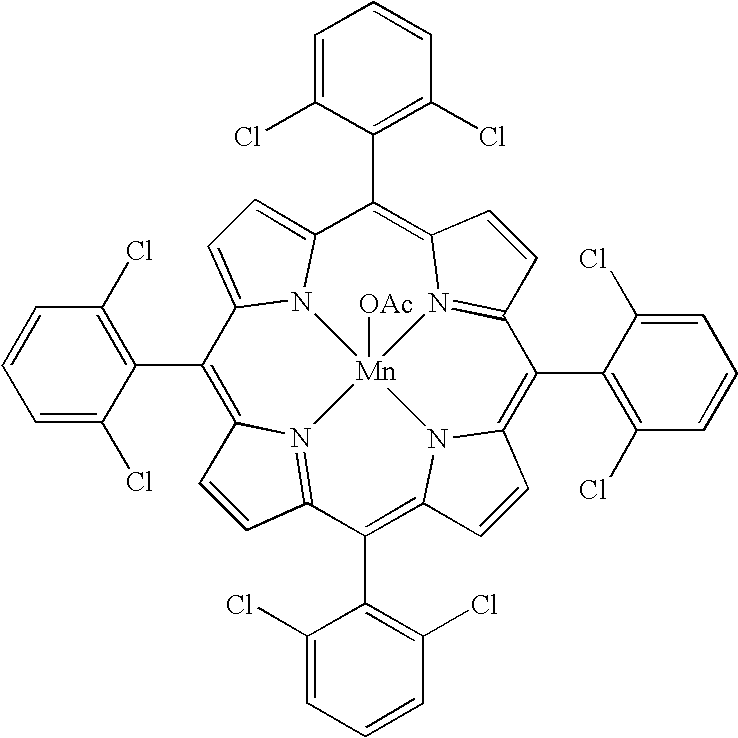Oxyfunctionalization of polyolefins
a polyolefin and polymer technology, applied in the field of oxyfunctionalization of polyolefins, can solve the problems of poor physical properties of polymer, poor application suitability, adhesion, etc., and achieve the effect of improving the physical properties of the polymer, reducing the molecular weight and/or increasing the polydispersity of the polymer
- Summary
- Abstract
- Description
- Claims
- Application Information
AI Technical Summary
Problems solved by technology
Method used
Image
Examples
example 1
Oxyfunctionalization of a Low Molecular Weight Poly(ethylene-alt-propylene)
[0015]A. Starting Materials—Imidazole, benzyldimethyltetradecylammonium chloride (BDTAC), potassium hydrogen persulfate (Oxone® oxidant), and sec-butyl lithium were obtained from Aldrich. Pyrrole was distilled before use. A cyclohexane solution of the polymer substrate was purified by stirring over H2SO4, followed by the neutralization of the organic layer by washing with a saturated solution of Na2CO3. The organic layer was dried over MgSO4 and passed through a column of neutral alumina. The filtrate was concentrated using rotary evaporation.
[0016]B. Synthesis of Poly(ethylene-alt-propylene) (PEP)—In a first step, polyisoprene is synthesized via anionic polymerization of isoprene. Catalytic hydrogenation of polyisoprene provides poly(ethylene-alt-propylene). Isoprene was purified by freeze-thaw degassing then further purified over n-butyl lithium and placed in a buret. Purified cyclohexane (1 L) was added to...
example 2
Oxyfunctionalization of a High Molecular Weight Poly(ethylene-alt-propylene)
[0022]The high-molecular-weight model PEP polymer was prepared using the procedure described above by changing the reaction stoichiometry. SEC equipped with a light-scattering detector provided an exact value for Mn=49.6 kg / mol and a PDI of 1.01 for the polyisoprene precursor. The Mn was found to be 55.2 kg / mol relative to polystyrene standards and a PDI of 1.06. SEC of the hydrogenated high-molecular weight model material, PEP, provided an apparent molecular weight of 61.4 kg / mol and a PDI of 1.07.
[0023]The oxyfunctionalization of the high-molecular-weight PEP was performed essentially as described in Example 1 except that chloroform was used as a solvent in place of methylene chloride and the reaction mixture was stirred at room temperature for three days. In this example, the following materials and quantities were used: Mn(TDCPP)OAc (19.5 mg, 19.0 μmol), imidazole (12.4 mg, 0.18 mmol), BDTAC (0.2814 g, 0...
PUM
| Property | Measurement | Unit |
|---|---|---|
| Mn | aaaaa | aaaaa |
| Mn | aaaaa | aaaaa |
| Mn | aaaaa | aaaaa |
Abstract
Description
Claims
Application Information
 Login to View More
Login to View More - R&D
- Intellectual Property
- Life Sciences
- Materials
- Tech Scout
- Unparalleled Data Quality
- Higher Quality Content
- 60% Fewer Hallucinations
Browse by: Latest US Patents, China's latest patents, Technical Efficacy Thesaurus, Application Domain, Technology Topic, Popular Technical Reports.
© 2025 PatSnap. All rights reserved.Legal|Privacy policy|Modern Slavery Act Transparency Statement|Sitemap|About US| Contact US: help@patsnap.com



